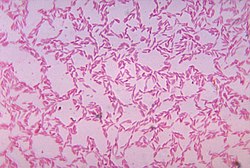| Bacteroidaceae | |
|---|---|
 | |
| Bacteroides biacutis anaerobically cultured in blood agar medium | |
| Scientific classification | |
| Domain: | Bacteria |
| Kingdom: | Pseudomonadati |
| Phylum: | Bacteroidota |
| Class: | Bacteroidia |
| Order: | Bacteroidales |
| Family: | Bacteroidaceae Pribram 1933 (Approved Lists 1980) [1] |
| Genera [2] [3] | |
| |
| Synonyms [2] | |
| |
The Bacteroidaceae are a family of environmental gram-negative bacteria commonly found in the human gut microbiota. [4]